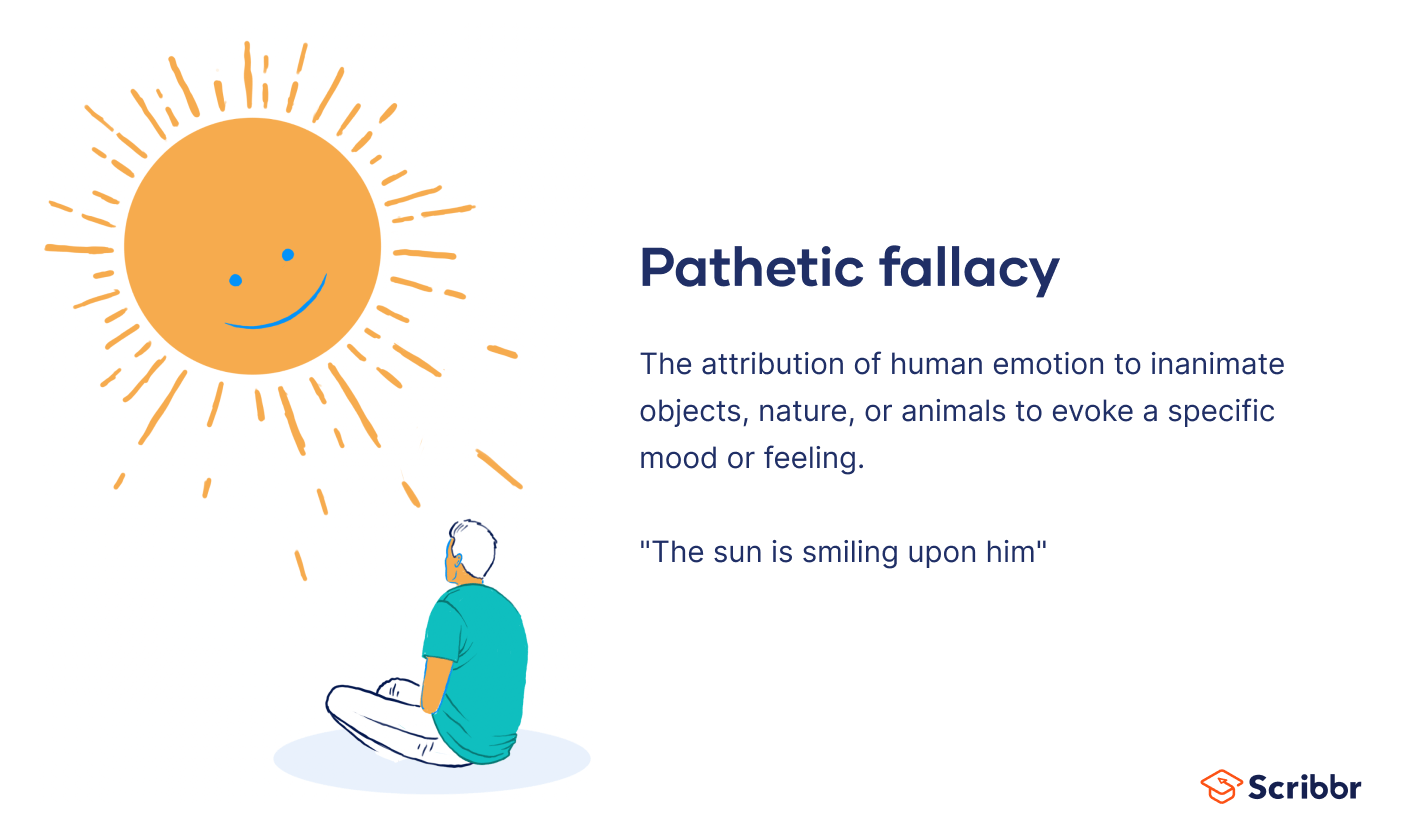What Is Pathetic Fallacy? | Definition & Examples
Pathetic fallacy is the attribution of human emotion to inanimate objects, nature, or animals. Writers use the pathetic fallacy to evoke a specific mood or feeling that usually reflects their own or a character’s internal state.
The raindrops wept around her.
A friendly sun shone down brightly on the party guests as they arrived in the garden.
Although the pathetic fallacy is perfectly acceptable in fiction writing, it may be perceived as a sign of faulty reasoning in scientific writing and is best avoided in that context.
What is pathetic fallacy?
Pathetic fallacy is a figure of speech or phrase that is used in a non-literal way to produce a specific effect. The pathetic fallacy occurs when inanimate objects, animals, or natural elements are treated as if they are able to experience feelings. In the example above, the weather is described with human emotions to reflect the mood of a character or create an atmosphere.
Pathetic fallacy is often used to describe the environment by projecting emotions onto nature. That’s why in novels we often encounter cruel thunderstorms, mournful birdsong, and smiling flowers. Non-human elements can be treated as characters to underscore what is going on in the story.
The word “pathetic” in this context is not used in its usual negative sense; instead, it relates to the word “pathos,” meaning emotion. Similarly, the word “fallacy” here means falseness (i.e., the sun doesn’t literally smile) and not flawed reasoning. If taken literally, a pathetic fallacy would be a reasoning error, but this is not how they are used.
Although a pathetic fallacy can be a useful teaching tool to convey scientific ideas, some advise against it because it can give a false impression of natural phenomena.
Pathetic fallacy vs. personification
Pathetic fallacy is a form of personification. While pathetic fallacy refers exclusively to the attribution of human feelings to something non-human (usually aspects of nature), personification has a broader meaning. Personification is the attribution of any human quality or action to something non-human—not only emotions.
For example, the phrase “the sun played hide-and-seek among the clouds” or “the rocking chair waited silently for Nana to return” are instances of personification because they describe something inanimate as exhibiting human behavior.
Pathetic fallacy examples
In literature, the pathetic fallacy is an indirect way to describe the characters’ emotional states or foreshadow things to come.
“Some say the Earth was feverous and did shake” (2.3).
“Is it night’s predominance, or day’s shame / That darkness does the face of earth entomb” (2.4.).
“Thou seest the heavens, as troubled with man’s act, / Threaten his bloody stage” (2.4).
Shakespeare uses the pathetic fallacy to describe nature (the earth is feverish and shakes, the day is ashamed, and the heavens are troubled because of the murder) and thus the state of affairs (a terrible crime has been committed). This also contributes to the play’s dark, sinister atmosphere.
Mary Shelley uses pathetic fallacy extensively in Frankenstein, which lends the story the ominous and gloomy atmosphere characteristic of Gothic novels.
- When Elizabeth is murdered, the wind rises “with great violence.”
- The creature’s growing hope that the cottagers will befriend him is reflected in the onset of spring, when “the birds sang in more cheerful notes.”
- When the protagonist recalls his peaceful days back in his homeland: “Its fair lakes reflect a blue and gentle sky; and, when troubled by the winds, their tumult is but as the play of a lively infant, when compared to the roarings of the giant ocean.”
Other interesting articles
If you want to know more about fallacies, research bias, or AI tools, make sure to check out some of our other articles with explanations and examples.
AI tools
Fallacies
Frequently asked questions about the pathetic fallacy
- Is pathetic fallacy a logical fallacy?
-
Pathetic fallacy is not a logical fallacy. It is a literary device or figure of speech that often occurs in literature when a writer attributes human emotions to things that aren’t human, such as objects, the weather, or animals.
Pathetic fallacy is used to reflect a character’s emotions. For example, if a character has lost a loved one, they may hear “mournful” birdsong.
- What is the difference between pathetic fallacy and appeal to pathos?
-
Pathetic fallacy and appeal to pathos sound similar but they refer to entirely different things.
- Pathetic fallacy is a figure of speech, at least in most contexts, and not a reasoning error. It refers to the attribution of human emotions to something non-human in novels or poems.
- Appeal to pathos, on the other hand, is a logical fallacy in which the speaker or author takes advantage of emotions, like fear or love for one’s family, to convince their audience instead of using rational arguments.
In other words, pathetic fallacy and appeal to pathos both relate to pathos or emotion but to a different end.
- Why do people use pathetic fallacy?
-
A pathetic fallacy can be a short phrase or a whole sentence and is often used in novels and poetry. Pathetic fallacies serve multiple purposes, such as:
- Conveying the emotional state of the characters or the narrator
- Creating an atmosphere or set the mood of a scene
- Foreshadowing events to come
- Giving texture and vividness to a piece of writing
- Communicating emotion to the reader in a subtle way, by describing the external world.
- Bringing inanimate objects to life so that they seem more relatable.
Sources in this article
We strongly encourage students to use sources in their work. You can cite our article (APA Style) or take a deep dive into the articles below.
This Scribbr articleNikolopoulou, K. (2023, September 04). What Is Pathetic Fallacy? | Definition & Examples. Scribbr. Retrieved April 22, 2024, from https://www.scribbr.com/language-rules/pathetic-fallacy/
Pager-McClymont, K. (2022). Linking emotions to surroudings: A stylistic model of pathetic fallacy. Language and Literature, 31(3), 428–454. https://doi.org/10.1177/09639470221106021




